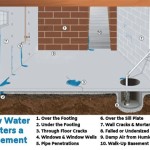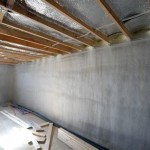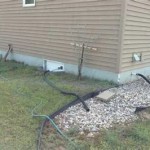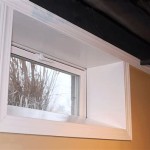Types of Basement Wall Insulation: Essential Considerations for a Warm and Dry Basement
Basement insulation is crucial for maintaining a comfortable, energy-efficient, and dry basement. By insulating your basement walls, you can prevent heat loss, reduce moisture, and create a more habitable space. There are several types of basement wall insulation available, each with its own advantages and disadvantages. Understanding these options is essential for making an informed decision. ### Fiberglass Batts Fiberglass batts are the most common type of basement wall insulation. They are made of fiberglass strands that are compressed into panels or rolls. Fiberglass batts are relatively inexpensive and easy to install, but they are not very effective at preventing moisture intrusion. ### Cellulose Cellulose insulation is made from recycled paper that is treated with fire retardants and other chemicals. Cellulose insulation is moisture-resistant and can help to absorb sound. However, it is more expensive than fiberglass batts and can be difficult to install. ### Spray Foam Spray foam insulation is a liquid foam that is applied to basement walls using a spray gun. Spray foam insulation is very effective at preventing heat loss and moisture intrusion, but it is also more expensive than other types of insulation. ### Rigid Foam Boards Rigid foam boards are made of extruded polystyrene (XPS) or polyisocyanurate (PIR). Rigid foam boards are moisture-resistant and can provide a high level of insulation. However, they are more difficult to install than other types of insulation. ### Reflective Radiant Barrier A reflective radiant barrier is a type of insulation that is made of aluminum foil or other reflective material. Reflective radiant barriers reflect heat back into the room, reducing heat loss. However, they are not very effective at preventing moisture intrusion. ### Choosing the Right Type of Basement Wall Insulation The type of basement wall insulation that you choose will depend on your specific needs and budget. If you are on a tight budget, fiberglass batts are a good option. If you are looking for a more moisture-resistant option, cellulose or spray foam insulation are better choices. If you want the most effective insulation possible, rigid foam boards are the best option. ### Installing Basement Wall Insulation Installing basement wall insulation is a relatively simple process, but it is important to follow the manufacturer's instructions carefully. Here are some general tips for installing basement wall insulation: - Start by cleaning the basement walls and removing any debris. - Install a vapor barrier on the walls to prevent moisture from entering the insulation. - Cut the insulation to fit the walls and install it according to the manufacturer's instructions. - Seal all cracks and gaps in the insulation to prevent heat loss. By following these tips, you can install basement wall insulation that will help to keep your basement warm and dry.
Keeping The Heat In Section 6 Basement Insulation Floors Walls And Crawl Spaces

Adding Insulation To Basement Walls Fine Homebuilding

Healthy Basement Insulation Systems Quality Built Basements Llc

How To Insulate A Basement Wall Greenbuildingadvisor

How To Insulate Basement Walls True Value

Keeping The Heat In Section 6 Basement Insulation Floors Walls And Crawl Spaces

Basement Wall Insulation Knauf

Inorganic Basement Wall Panels In Stamford Norwalk West Hartford By Expert Contractors To Beautiful Insulated

Best Type Of Insulation For Basement Walls

Keeping The Heat In Section 6 Basement Insulation Floors Walls And Crawl Spaces








